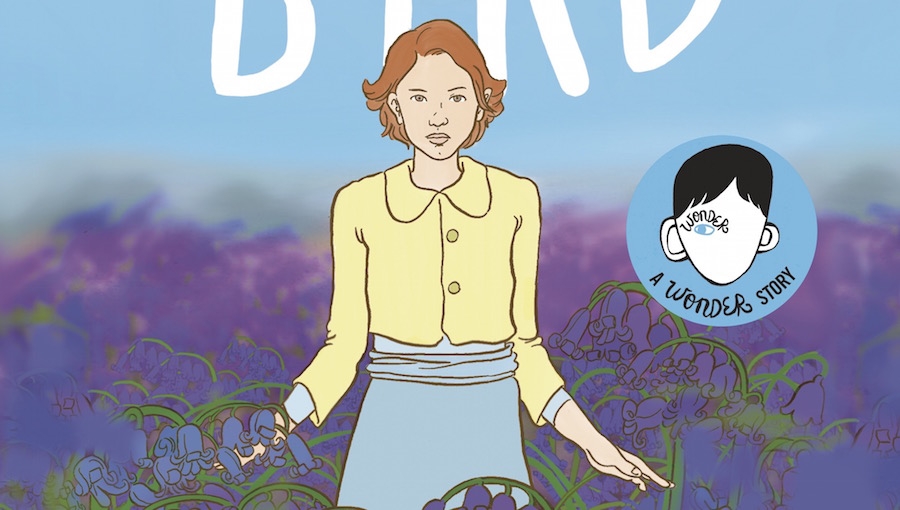Those who cannot remember the past are condemned to repeat it. – George Santayana
White Bird: A Wonder Story marks award-winning novelist R. J. Palacio’s debut in the graphic novel medium of storytelling. Fans of Palacio likely recognize her name; she wrote the best-selling novel, Wonder, that was adapted into a 2017 film starring Julia Roberts and Owen Wilson, and Auggie & Me, one of several successful follow-up novels. Interestingly, it was one of the characters in the latter novel that inspired this graphic novel.
In Auggie & Me, Grandmère’s wartime experiences motivated many parents and teachers to contact Palacio, relating that the character’s story was an excellent lead-in to introduce young readers to themes arising from the Holocaust. Palacio related in a 2018 interview in Publisher’s Weekly (See her interview with Sally Lodge here.) that there were many similarities between Grandmère wartime story and the news of deportations and bans being reported in 2016. Palacio was “worried about the impact this is having on our children, who are witnessing these events without the historical context they need to process them.” She realized that children needed a book in which they could learn about these important themes earlier than middle school, when students are typically assigned to read Anne Frank’s seminal The Diary of a Young Girl. White Bird was the result.
White Bird opens with teenager Julian calling her Grandmère about a school project requiring her to interview someone she knows. She asks her grandmother if she can interview Grandmère about her experiences during World War II. Her grandmother is hesitant but then agrees, saying that she will share details with her granddaughter that she has not shared before. Readers travel back with Grandmère to a German-occupied France, where Jews were no longer safe. Grandmère had been a teen when she became separated from her parents, and a classmate’s family takes her in and keeps her hidden as war raged on. In spite of the danger, the kindness of her classmate and his family saved Grandmère and ensured that she would survive the war.
While the events of WWII provide historical context to a narrative that readers learn in their history classes, Palacio’s story is compelling and captures the tension and danger of Grandmère’s situation. Her story comes alive as a result of Palacio’s closeness to the wartime experience – her Jewish husband’s mother lost family during the war – and her skills as a writer are emotionally charged by her compassion and engagement with the historical material. Palacio stated in the same interview, “It’s staggering and sad that we find ourselves in these prejudicial times again,” and the modern application of White Bird’s message will not and more importantly, should not be lost, to each reader. Although Grandmère’s story is sad, it is also uplifted by the message of kindness, a theme that runs through all of Palacio’s books. It is a story that will linger on the reader’s mind long after the last page is turned. As Anne Frank’s diary is associated with my generation’s introduction to the Holocaust, I do believe that White Bird will become our children’s introduction to a historical moment that must not be forgotten.
Palacio illustrated White Bird. Her panel layouts are simple and straightforward for younger readers to follow. She also focuses her attention on facial expressions to convey the emotional journey of the story and keeps the backgrounds subdued and subtle – representative of the historical era she is capturing in her story. Kevin Czap provides his inking skills, and, together, they provide seamless, gorgeous visuals. Additional materials such as a glossary of terms, suggested reading list, organizations/resources, author’s note, and an afterword by Ruth Franklin encourage readers to discuss and learn more after finishing White Bird. These are useful tools for parents seeking ways of mediating the story with their children.
For those attending the New York Comic Con next week, seek out the panel, “Sharing One’s Truths: Non-fiction, Memoir, Historical Fiction, and More,” taking place on Thursday, October 3, at 4 p.m. in Room 1A18 (Check NYCC’s program to confirm final schedule details.), where Palacio, along with other panelists, will discuss their respective non-fiction stories.
White Bird: A Wonder Story is listed at Penguin Random House as appropriate for pre-teen (8 – 12 years old) readers and will release on Wednesday, October 2, in comic book stores.
Creative Team: R. J. Palacio (writer/illustrator); Kevin Czap (inks)
Publisher: Alfred A. Knopf Books for Young Readers (Penguin Random House)
Click here to purchase.

